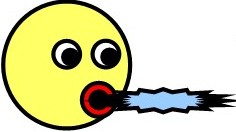Well, 1960 is of interest to me because it is the year I was born, and here was a documentary that showed not just the two candidates, but the society of the time. The documentary took place from March to April 5th, when the primary election was held. It was the same country that I was born into about three weeks later, one that has changed quite a bit in the last few decades. So I flicked it on.
On shows like this one, I'm just as interested in what the places looked like, what the people looked like, what they were wearing, what they were driving. They say that the past is a foreign country, and this one was very alien to the visitor from 2008.
The cars were all from the 1950s, of course; 1960 had just begun, after all. And they were all American-made, with not a foreign car to be seen. Bulbous Detroit iron with lots of chrome and big tailfins, like the recently invented intercontinental ballistic missiles, meant to impress with their bulk alone. And with gasoline almost as cheap as water, who cared about gas mileage?
The men were mostly wearing suits and hats, although at one rally, Humphrey addressed a group of farmers mostly dressed in overalls, talking about farm subsidies (he was in favor of them). The women all were wearing dresses with long skirts. "Cat glasses" were in vogue for the ladies.
Both candidates spent a lot of time glad-handing the locals in the small towns of Wisconsin, signing autographs, shaking hands. The young people seemed particularly enthused by Kennedy. The graphics in the home-made signs in the background at a Humphrey call-in television show looked amateurish compared to the glitzy campaign signs of 2008.
Humphrey was much younger than I remembered him being when he won the Democratic nomination eight years later. Still, he seemed older than Kennedy, who was a youthful 42 years of age at the time. There was also a marked contrast in styles, with Humphrey always wearing a hat when outdoors, as most men still did at the time, while the trendsetting Kennedy was bare-headed to show off his full head of hair. Jackie Kennedy was with him at some of the campaign rallies, and brother Bobby showed up for one memorable cameo. Amazingly, Humphrey and Kennedy were the only ones campaigning in 1960; according to the Wikipedia article on the 1960 U.S. Presidential election:
[Stuart] Symington [of Missouri], [Adlai] Stevenson [of Illinois], and [Lyndon] Johnson [of Texas] all refused to campaign in the presidential primaries, thus limiting their chances of winning the nomination. All three men hoped that the other leading candidates would stumble in the primaries, thus leading the Democratic Convention's delegates to choose them as a "compromise" candidate acceptable to all factions of the party.How times have changed! Can you imagine a candidate today hoping that everyone else will screw up and the nomination will just fall into his (or her) lap?
I was also surprised that only 14 states and the District of Columbia had primary elections in 1960. How did the other 36 states select which candidate to support? Did the state party bigwigs just get together in a smoke-filled room and say, "Joe Blow is our guy"?
Then there was the campaign music. The Kennedy campaign used "High Hopes" with different lyrics, while the Humphrey campaign chose an altered-lyrics version of "Davy Crockett"; one scene has four guys playing it on accordions. Yeah, it was cheesy, but hey, we're talking about Wisconsin, after all!
It was interesting to see more footage of JFK than I've seen in the past. There are a few clips from iconic speeches and the film from the assassination that we've all seen, but not much of Kennedy behind the scenes just being himself. This documentary had some of that, with some behind-the-scenes Jackie as well. It was endearing and more than a little sad, knowing what was to come later.

